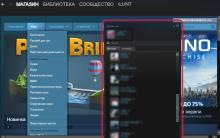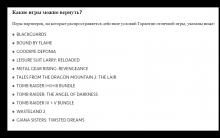How to organize a screen pixel ruler in the Windows environment in order to measure the length and height of windows or other interface elements and adjust them to their sizes? Such a specific task can be faced not only by designers or developers, but also by ordinary users working with documents or projects of their specialized software. Consider below three programs for the implementation of the screen ruler.
1. SPRuler
SPRuler - a small free utility SPRuler is not intended for anything more than displaying a screen pixel ruler on the Windows screen. It displays two scales: at the top with an interval of 10 pixels, at the bottom - 8 pixels. The scales are swapped in the context menu options. In the same place, we can change the orientation from horizontal to vertical, apply light or dark colors of the ruler, adjust its transparency. It increases or decreases by the usual pulling off the edges or by specifying a specific value in the options. Copies of the ruler with horizontal and vertical orientation can be launched as desired. There is support for hot keys.
2. Window Ruler
Window Ruler is another free minimalistic utility that implements both horizontal and vertical rulers in the Windows environment. But not only pixel, the sizes of objects on the screen can also be measured in points (typographic points), inches, centimeters and millimeters. The ruler is enlarged and reduced by pulling off the edges. The dimensions of the screen area specified in the window are displayed in the lower right corner of this area. Window Ruler does not provide the ability to manually enter size values, but it does have options for setting five areas with standard screen sizes.

3. FastStone Capture
The on-screen ruler is included in the functional paid screenshoter - the FastStone Capture program. This is an option for complex work on creating screenshots with adjusting the elements of the Windows interface to the desired dimensions. For example, for implementation in documents, presentations, other projects of programs for creating content, publishing on the Internet. The FastStone Capture ruler can be switched from horizontal to vertical by double-clicking on it; its size is changed by dragging it off the edges. There is no possibility of manual dimensioning, but there is an option to display a small scale interval, to which the cursor is brought, in an enlarged scale. The predefined units of measurement in pixels can be changed to inches or centimeters. The color and transparency of the ruler is customizable. For ease of launching it can be added to the floating quick access toolbar for FastStone Capture operations.
Hello, friends! The online screen ruler is indispensable for many works, in the article we will consider the installation of the program FS Capture and using its functionality. It is convenient to work with the on-screen ruler when working with pictures on websites, when creating and revising subscription and selling pages.
FS Capture online editor screen ruler
The blogosphere requires the application of a variety of knowledge and tools to solve different problems. One of these tasks in the blogosphere is measuring various objects on the pages of a blog (site), as well as determining the size of various graphic images when replacing pictures in blog templates, when preparing subscription and selling pages, sizing banners and much more.
Since many beginners have never encountered the need to carry out such measurements before, it is likely that not all of them are aware of the availability of a special tool for taking measurements on the monitor screen. A tool for measuring on a monitor screen is called a screen ruler, i.e. the online screen ruler, we will talk about it in this article, I think that such information will be useful for beginners.
So where do you get the on-screen ruler? First, there are target programs like VRCP SPRuler, mySize, PixelWindow and others. Secondly, there are graphic editors that have built-in functions of the screen ruler, one of such editors is FS Capture.
The graphics editor FS Capture (Fast Stone Capture) is very common among bloggers, it has many useful functions: capturing images from the monitor screen, including scrolling, creating screenshots, the ability to apply watermarks, creating various arrows, capturing images, editing and image correction, you can also record presentations and sound.
FS Capture editor contains in its arsenal and screen ruler. If you do not have this graphic editor yet, then I advise you to start it, it will do a good job. Old versions of FS Capture can be downloaded on the Internet for free, new versions are paid. Previously, I used version 5.3, now I use 6.5.
So, after installing the Fast Stone Capture program, open the image you need, then open the Fast Stone Capture program. To connect the screen ruler, you must press the rightmost button "Settings" (see screen 1).

In the window that opens, select the "Screen ruler", after clicking on this button, the screen ruler opens.
On the right, with the mouse, we can reduce and increase the length of the ruler (screen 2), and with the help of the hand, the ruler can be moved across the monitor screen. When measuring a graphic object, an enlarged scale is displayed in the upper right or left corner, which allows very accurate measurements.

To put the ruler vertically, you need to click on one of the arrows (screen 2 is highlighted in yellow). You can use the roulette function, for this we press the double arrow at an angle (screen 3).

If you press the arrow inside the rectangle (screen 4), the settings panel opens with the on-screen ruler. You can choose the horizontal or vertical position of the ruler, you can choose its color and transparency. Here you can also choose the unit of measurement - pixels, centimeters and inches.

In such a simple way, you can measure objects on a blog and in other graphic editors. Of course, everyone decides whether to download a separate program, or use the built-in functions of the graphics editor.
If the readers are interested, then in the future I can prepare an article on the use of the Fast Stone Capture graphic editor, an online screen ruler, for image editing. Good luck to you
Receive new blog articles directly to your inbox. Fill out the form, click the "Subscribe" button
Let's start with an English-style ruler. It has 12 graduations (large marks) representing inches. 12 inches equals 1 foot (30.5 cm). Each inch is divided into 15 divisions (small marks), that is, each inch on the ruler is indicated by 16 marks.
- The higher the mark, the higher the indicator. From the 1 "mark to the 1/16" mark, the marks are reduced in size in accordance with the decrease in performance.
- The ruler reads from left to right. If you are measuring an object, line up the beginning (or end) with the left end of the ruler. The number you find on the ruler on the right determines the length of the item.
There are 12 inch divisions on the English-style ruler. They are numbered and indicated by the largest marks. For example, if you need to measure the length of a nail, align the beginning (or end) with the left end of the ruler. If the end (or beginning) of the nail aligns with the large "5" mark, then the nail is 5 inches long.
- Some rulers also have 1/2 "marks, so do not confuse the largest inch marks with the smallest ones.
1/2 "marks. These marks are half the length of inch marks. They are placed in the middle of each 1-inch mark because they represent half an inch. That is, such marks are applied between 0 and 1 inches, 1 and 2 inches, 2 and 3 inches, and so on. There are 24 such marks on the 12-inch ruler.
- For example, line up the left end of your ruler with the tip of your pencil eraser. If the tip of the lead points to the mark between the 4 "and 5" marks, then the pencil length is 4 and 1/2 inches.
1/4 inch marks. These marks are placed in the middle of the 1/2 "marks, are smaller and represent 1/4". In the first inch, these marks represent 1/4, 1/2, 3/4, and 1 inch. Although there are separate marks for "1/2" and "1", these are included in the 1/4 "measurements because 2/4" is half an inch and 4/4 "is 1 inch. There are 48 such marks on the 12-inch ruler.
- For example, if you are measuring a carrot and the end aligns with the mark between the 6 1/2 and 7 marks, then the length of the carrots is 6 and 3/4 inches.
1/8 ”marks. These marks are placed between the “1/4” marks. There are markers between 0 and 1 inches denoting 1/8, 1/4 (or 2/8), 3/8, 1/2 (or 4/8), 5/8, 6/8 (or 3/4) , 7/8 and 1 (or 8/8) inches. There are 96 such marks on the 12-inch ruler.
- For example, you are measuring a piece of fabric and the edge aligns with the 6th mark after the 4 "mark, which is directly between the 1/4" and 1/2 "marks. This means that the length of the fabric is 4 and 3/8 inches.
1/16 inch marks. These marks are placed between the “1/8” marks. These are the smallest marks on the ruler. There are markers between 0 and 1 inches denoting 1/16, 2/16 (or 1/8), 3/16, 4/16 (or 1/4), 5/16, 6/16 (or 3/8) , 7/16, 8/16 (or 1/2), 9/16, 10/16 (or 5/8), 11/16, 12/16 (3/4), 13/16, 14/16 ( or 7/8), 15/16, 16/16 (or 1) inches. There are 192 such marks on the 12-inch ruler.
- For example, you are measuring a flower stem and its end is at the 11th mark after the 5 "mark. In this case, the stem length is 5 and 11/16 inches.
- Not every ruler has 1/16-inch markings. If you plan on measuring small items, or want to take accurate measurements, make sure your ruler has these marks.
Not so long ago I had to review one program in the description of which it was necessary to indicate the exact length and width of the toolbar. As you can imagine, there could be no question of determining the dimensions “by eye”, the length and width had to be indicated exactly and, moreover, not in centimeters and millimeters, but in pixels.


Arigato ruler
Then I decided to try another free line - Arigato Ruler. Unlike Screen Ruler, it has a clearer scale of divisions and plus a customizable screen magnifier. And besides, it can be used to measure the color and determine the exact position of the mouse cursor in space. Supports transparency, reflection, background change, position change, copy color value.
You can move the Arigato Ruler around the screen both with the mouse and with the arrows (the latter gives high accuracy). By the way, it is also portable.
Universal Desktop Ruler
If this is not enough for you, I can offer one more tool, however, this time a paid one - Universal Desktop Ruler - a universal screen ruler.
With its help, you can measure not only the width and height of the object, but also the area, as well as the perimeter. In addition, Universal Desktop Ruler can measure angles, the length of oblique lines, count the number of objects on the screen, and also save the history of previously made measurements to a log. Download Universal Desktop Ruler 3.6:
It is often necessary to measure something on your monitor screen. This need most often arises when working with pictures. When you need to print something, and you are not sure that on paper the result will be the same as you expected. For example, I used to use an ordinary sheet of paper in a box, fit it to the screen and so I recognized the size of a picture or something else.
It's not that I'm such a teapot, it's just that I didn't have such an urgent need for ruler programs. But for those who work a lot with graphics, printers, or just need to measure something, I have prepared a description of several rulers and links to pages where you can download them.
Metric ruler
JR Screen Ruler is the only ruler I could find with centimeter units. But besides centimeters, you can still measure in pixels, inches and peaks.
Works in all windowed Windows applications, just drag and drop wherever you need. It is possible to turn the ruler vertically and horizontally.

The disadvantages of this program include the inability to change its color and the need to customize it. Without adjustment, there is a possibility of a large measurement error.
It is very easy to set up, select the unit of measurement you need, let's say a centimeter.
Attach a regular plastic ruler to the monitor screen (to the virtual ruler) and compare how much the scale readings diverge.
If everything matches, then the setting can be skipped. If there is still a discrepancy, then you need to change the number of pixels per unit of measurement. To do this, right-click on the ruler and select Pixels per inch. And in the Input Box, change the pixel values until the centimeters become centimeters. For example, my value was 105.

You can download the program from the official website. The size is less than 500 KB, does not require installation, you can get started right away.
Browser ruler
I can recommend a couple of cool lines for those who use the Google Chrome browser

Ruul. Screen ruler - beautiful pixel rulers, you can use several pieces at once on one page. As you already understood, we are talking about expansion. Rather suitable for a developer, since it is possible to work with them only in the browser. There is even a special memo showing how letters of different sizes look in pixels. There is one drawback - this extension does not work on all pages, for example, on the Google website.

Last but not least, my favorite is Ruler Opera Widget. Nothing special at first glance, but for some reason I really like this widget. Unfortunately only pixel scale but works in all windows windows. Whether it's a browser, notepad, desktop or any folder.
For some reason it was removed from the Opera Add-on, where you can find it in Yandex or Google.











Prolongation of registration of participants in the "Living Classics" competition!
Who deleted me from friends on VKontakte All friends disappeared from the contact
Which operator was the best in Russia
Double cassette tape recorder
"VK" can be closed for a long time